Visit your favourite destinations |
| A Report from birdtours.co.uk |
Vendėe and Charente Maritime 14th to 29th August August 2009,
A family holiday on the Atlantic Coast of France provided some excellent birding opportunities at a fairly leisurely pace. We caught the ferry from Poole to St Malo staying overnight in the French coastal town before moving on to our holiday destination, St Hilaire de Riez, the next morning. The ferry gave us an opportunity to overlook the lagoon on Brownsea Island where hundreds of terns were still present, together with Little Egrets and a few Spoonbills. The sea crossing was uneventful except for many Gannets, a few Fulmars and a Great Skua.
The next morning a walk along the beach at St Malo produced a couple of Roseate Terns amongst regular gull species. These terns breed on the rocky islands on the approach to the harbour.
Driving on to our destination we didn’t get to see much until we were over the St Nazaire bridge over the Loire. Once into the marshes around Beauvoir–Sur–Mer we saw a couple of Black Kites, Cattle & Little Egrets, Marsh & Montagu’s Harrier and a Short-Toed Eagle from the D51 road. Cattle Egrets have obviously spread into this area significantly since our last visit in 1997 when we didn’t see one.
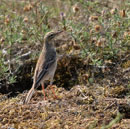 |
We stayed at “Mas de St Hilaire” near to the seaside resort of St Jean de Monts. The area is typified by long sandy beaches, much beloved of French holiday makers, and extensive sand dunes backed by pine woods, which were planted in the 19th century to stop the “ensablement” (sanding up) of the coast. Several early morning walks through the woods to the beach via the dunes revealed a party of at least a dozen Tawny Pipits on one occasion; either a migratory group or a post-breeding flock. Other species noted were: a Hoopoe, Crested Tit, Short-Toed Treecreeper, a Hobby, several Kestrels, Green & Great-Spotted Woodpeckers, Linnet, Goldfinch, Whitethroat, together with migrating Willow Warblers, Chiffchaff and Turtle Dove; Sandwich Terns fished off the beach regularly. During our stay a harrier species (probably a Hen by its size) and a Honey Buzzard soared over our villa. |
One day whilst my family were “chilling” by the pool I went out for the day visiting Pointe D’Aiguillon, Poirė Velluire Common and St Denis du Payrė.
The whole coast and Pointe D’Aiguillon in particular is one of the finest places in France to see huge numbers of wader, terns and gulls, it also has a good range of breeding passerines and raptors. Luckily the tide was out when I arrived and I stopped by the “Pergola” restaurant to scan the mudflats; birds noted here were: Black-Tailed & Bar-Tailed Godwits, Curlew, Curlew Sandpiper, Greenshank, Redshank, Grey Plover, Ringed Plover, Dunlin, Knot, Oystercatcher, the ubiquitous Sacred Ibis, and Little Egret. Similar birds were seen further on by parking and climbing up the sea wall further along the road. At the “Pointe” I managed to scope a couple of “carrot-billed” Caspian Terns resting on the mud, together with a number of Sandwich & Little Terns. In the dunes at least six Tawny Pipits entertained, a Bluethroat dived tantalisingly into a Tamarisk bush, a Sedge Warbler and several Willow Warblers skulked, a few Skylarks were flushed, a Northern Wheatear stood sentinel on a fence post, Turtle Doves hurried over to an uncertain future, and several thousand Sand Martins with a few Swallows skimmed and chirruped overhead. Retracing my steps in the direction of Aiguillon-sur-Mer, I turned right towards La Dive, and then right again by a silo until I came to a bridge over a watercourse. On my last visit you couldn’t go beyond here, but you are now invited to walk along the private track through the cornfields, beyond which you can view over the northern edge of the bay. A hide has even been built on the sea wall. This area is good for raptors: Marsh & Montagu’s Harrier – one ringtail “Monts” sported wing tags blue on the right, yellow on the left, Common Buzzard, and several Kestrels. Fan-Tailed Warblers “zipped” from the ditches, and hundreds of Blue-Headed Wagtails fed in the fields with a few Whinchats. The dried up ditch just before the sea wall revealed a family of four Bluethroats with more Blue-Headed Wagtails, two Whinchats, and a couple of Common Sandpipers. From the hide thousands of common waders were present – Curlew, Dunlin, Ringed Plover, and Black-Tailed Godwit. Noteworthy was an Osprey, which was perched on a post in the middle of the mudflats.
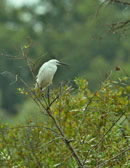 |
The next port-of-call was Poirė Velluire Common, which is said to be a congregating place for Little Bustard in late autumn. Basically it’s just a huge square of rough pastures made into a nature reserve “grâce aux chasseurs” (with thanks to the hunters). There is a public hide on one side of the reserve just outside the village of L’Angleė that has a peculiar periscope affair, and which is basically useless for birders with scopes; all I saw from here was a Lapwing. Turning into a pleasantly tree-lined lined avenue – Route des Hollandais – some watery inlets gave good views of several hundred Lapwings, six Cattle Egrets, a Kingfisher, with some Mallards and Moorhens. Needless to say I didn’t see any Bustards, which are evidently in severe decline in this area verging on extirpation. |
A little disappointed I moved on to the reserve at St Denis du Payrė where there is a hide overlooking some pools and rough pastures. On a previous visit in May during the 1990’s, I remember it only being open on Sunday afternoons, but having checked I discovered that it was open in the morning and afternoons In July and August, with the usual French lunch break in between. Quite why such a wonderful location is only open for such short periods is difficult to comprehend for a British birder used to much easier access at home.
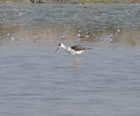 |
Arrangements for getting to the hide are also further complicated by having to drive into the village for a permit at the visitor centre. The warden on site refused to sell me a ticket and wouldn’t let me stay even for 10 minutes. When I remonstrated with him that access would be much easier in Britain he said to me, “But Monsieur you are in France!” - well I supposed that I asked for that one: a lesson for my insular arrogance. Having overcome the bureaucracy I enjoyed a couple of hours enjoying a flock of thirty-eight Spoonbills and two Short-Toed Eagles, which soared overhead. Other birds on site included: Black-Winged Stilt, Little Egret, Marsh Harrier, Spotted Redshank, Whimbrel, Black-Tailed Godwit, Snipe, Common Sandpiper, and Turtle Dove. The White Storks, which nest on the reserve, had unfortunately departed. |
My next outing was to the Lac de Grand Lieu, a site I had not visited before. Access here is not easy but you can obtain reasonable views from several points. Most of the lake is now a nature reserve although hunting is still permitted over a large part of it. The following link to the SNPN (Sociėtė Nationale de Protection de LA Nature) http://www.snpn.com/spip.php?article83 gives you a starting point.
First of all I drove to St Luminė de Coutais where you can allegedly obtain views over the area from the Church tower. The tower can be accessed by asking for a key from a bar called “Le Cheval Mallet” opposite or the “Mairie” or town hall. Needless to say that both were closed when I visited. Having seen how far away the church is, you would get great views over the lake in the distance, but they would not be birder’s views! There is a peripheral network of paths and cycle tracks which take you through some good habitat, but which get you nowhere near to the lake itself. From the tracks the only birds of note were Cattle & Little Egrets, Sacred Ibis, some Blue-Headed Wagtails amongst the cattle, and a Spotted Flycatcher. At a small area of open water known as the “Port,” a family party of Kingfishers was evident. I didn’t linger in the area, as there were a number of small Renault vans parked nearby and the distant sounds of gunshots. Several Willow Warblers and Chiffchaff gave their melancholy autumnal “wheet” from roadside bushes.
 |
Passay was much more accessible, although a hide further into the reserve behind a locked gate was only accessible at weekends by booking a ticket in the fisherman’s centre adjacent to the shore. From a bay used by fisherman I watched several Great White and Little Egrets fishing, heard and saw several Fan-Tailed and Cetti’s Warblers. In the far distance I could make out more egret species, Spoonbills, Sacred Ibis, and several Marsh Harriers. A Honey Buzzard soared in seamless, effortless flight over some woods, and two vociferous Greenshanks scurried overhead. Commoner birds included thousands of Black-Headed Gulls, Mallards, with a few Coots, Cormorants, Great Crested Grebes, Tufted Ducks, Moorhens, White Wagtails and Grey Herons |
Incidentally Passay is a great spot of you’re into to aeroplane spotting as it’s on the flight path to both civilian and military airports in Nantes. During my visit I saw a German transport plane sporting the iron cross and the word Luftwaffe, a private-looking jet with arabic script on the fuselage, and best of all the surreal looking “Beluga” transport plane, which is a converted “Airbus” used for carrying aircraft parts around the world – strange days indeed!
 |
I drove back via the marshes around Beauvoir-sur-Mer and Bouin in a gathering storm, which never quite materialised. The road from Bouin to Port-les-Champs under the huge wind turbines was quite productive with Little & Cattle Egrets, Marsh Harrier, Red-Legged Partridge, Avocet, Black-Tailed Godwit, Green Sandpiper, Redshank, “zitting” Fan-Tailed Warblers, scores of Kestrels, big flocks of House Sparrows, Corn Bunting and some post-breeding Sandwich & Common Terns. |
I found the next site by looking at the LPO Vendeė http://vendee.lpo.fr/ website, the lake at Machė Apremont. It doesn’t appear in any of the “Where to Watch etc” guides but was obviously someone’s local patch. What drew me to it was that there had recently been four Caspian Terns and assorted waders there. The best area is the exposed mud beyond the bridge near to the village of Machė in the north-east corner of the lake. The lake is quite accessible with a cycle & pedestrian path along the perimeter. I had a strange experience here, as immediately after getting out of the car I heard what sounded exactly like a Wryneck calling from a line of tall trees at the start of the footpath. Being curious, as Wrynecks don’t call on migration, I waited until whatever was making the noise showed itself. Eventually two birds started calling and then one flew – a small green parakeet with a grey head – a Monk Parakeet! Beyond the bridge the area was very productive with four Caspian Terns, a Spoonbill and two Cattle Egrets being the highlights. Other waders included Black-Tailed Godwit, Green Sandpiper, Common Sandpiper, Greenshank, Ruff, Snipe, Ringed & Little Ringed Plover. As elsewhere there were huge numbers of Sand Martins migrating, this time with a few House Martins for company. Turtle Doves continued south in ones and twos. Certainly a site worth visiting.
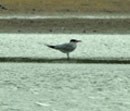 |
The Ecomuseė de Daviaud located just off the D51 near to St Jean de Monts, which has a converted barn serving as a hide was well worth a visit, although birdwise all we saw was a Marsh Harrier, a few Kestrels and a Wheatear. |
My last trip was an evening visit to the marshes near to Bouin, culminating in a high tide watch at the Passage du Gois, a causeway leading to Noirmoutier Island that is only passable at low tide. Just south of St Urbain on the D59 road we saw five White Storks circling perhaps looking for a roost for the night. Little & Cattle Egrets were seen everywhere. Sitting on the seawall just above the Passage du Gois, my youngest son and I watched a great spectacle as the tide drove hundreds of birds that been feeding in the vast Baie de Bourgneuf towards the shore.
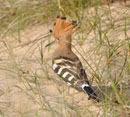 |
There were hundreds of Mallard sat on the sea with Shelduck, Dunlin, Oystercatcher, Curlew, Turnstone, Ringed Plover, Greenshank, Black & Bar-Tailed Godwit, Grey Plover, Avocet, Whimbrel, all joining into a chorus of seeming panic as the waters advanced. Here Mediterranean Gull was more common than Black-Headed with well over a hundred present. An adult female Hen Harrier caused further panic amongst the wader flocks. A great way to end the day and almost the holiday. |
On the way home we noted several Honey Buzzards migrating southwards, just north of Bouin and near to Pontchâteau. We did make a brief lunch stop at the Fôret de Gâvre north of Nantes hoping for the rarer woodpeckers, but all we saw in just over an hour were a couple of Firecrests and a Great-Spotted Woodpecker.
Sailing back from St Malo we were unlucky enough to catch the tail-end of “Hurricane Bill” and as I stood on the heaving deck amongst the “heaving” passengers my thoughts turned to all those shearwaters and petrels passing in the dark!
SYSTEMATIC LIST
Great-Crested Grebe
Little Grebe
Fulmar
Cormorant
Shag
Northern Gannet
Great Skua
Grey Heron
Great White Egret
Little Egret
Cattle Egret
Sacred Ibis
Mute Swan
Greylag Goose
Mallard
Teal
Tufted Duck
Shelduck
Short-Toed Eagle
Marsh Harrier
Montagu’s Harrier
Hen Harrier
Common Buzzard
Honey Buzzard
Black Kite
Osprey
Kestrel
Hobby
Sparrowhawk
Pheasant
Red-Legged Partridge
White Stork
Coot
Moorhen
Ringed Plover
Little Ringed Plover
Grey Plover
Lapwing
Dunlin
Avocet
Black-Winged Stilt
Oystercatcher
Black-Tailed Godwit
Bar-Tailed Godwit
Curlew
Whimbrel
Common Snipe
Green Sandpiper
Ruff
Greenshank
Redshank
Spotted Redshank
Common Sandpiper
Curlew Sandpiper
Red Knot
Turnstone
Great Black-Backed Gull.
Lesser Black-Backed Gull
Yellow-Legged Gull
Herring Gull
Meditteranean Gull
Black-Headed Gull
Kittiwake
Sandwich Tern
Caspian Tern
Common Tern
Roseate Tern
Little Tern
Black Tern
Whiskered Tern
Woodpigeon
Turtle Dove
Collared Dove
Great Spotted Woodpecker
Green Woodpecker
Short-Toed Treecreeper
Skylark
Kingfisher
Swallow
House Martin
Sand Martin
Blue-Headed Wagtail
Pied “White” Wagtail
Tawny Pipit
Northern Wheatear
Bluethroat
Whinchat
Robin
Blackbird
Song Thrush
Mistle Thrush
Sedge Warbler
Blackcap
Whitethroat
Willow Warbler
Chiffchaff
Fan-Tailed Warbler
Cettis Warbler
Firecrest
Spotted Flycatcher
Great Tit
Blue Tit
Crested Tit
Long-Tailed Tit
Magpie
Jay
Starling
Crow
Jackdaw
Chaffinch
Goldfinch
Linnet
House Sparrow
Dunnock
Corn Bunting
115 bird species seen or heard.
Escapees
Black Swan
Monk Parakeet
Butterflies & Moths
The only ones identified were Silver-Washed Fritillary and Cardinal.
Hummingbird Hawkmoth.
Mammals & Reptiles
Red Squirrel
Coypu
Common Lizard
Green Lizard
Why not send us a report, or an update to one of your current reports?